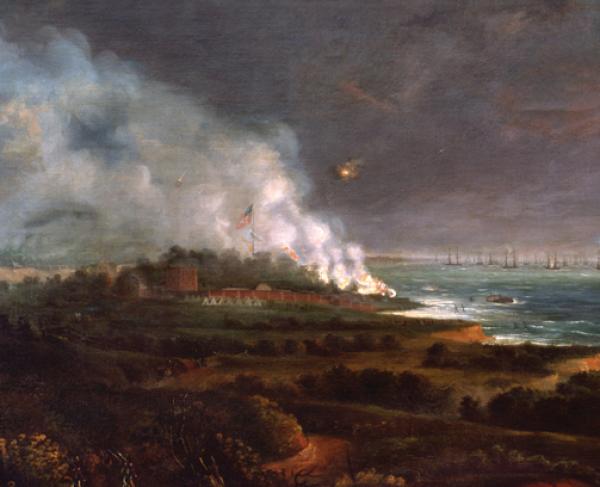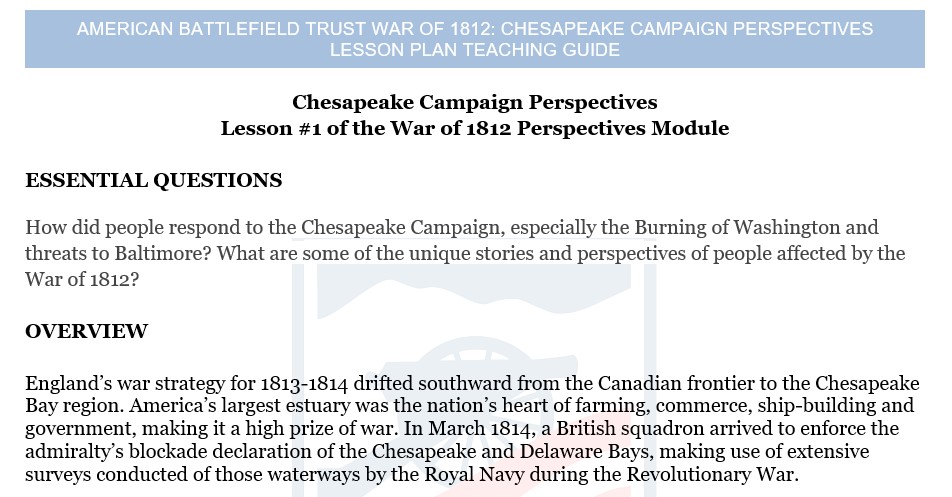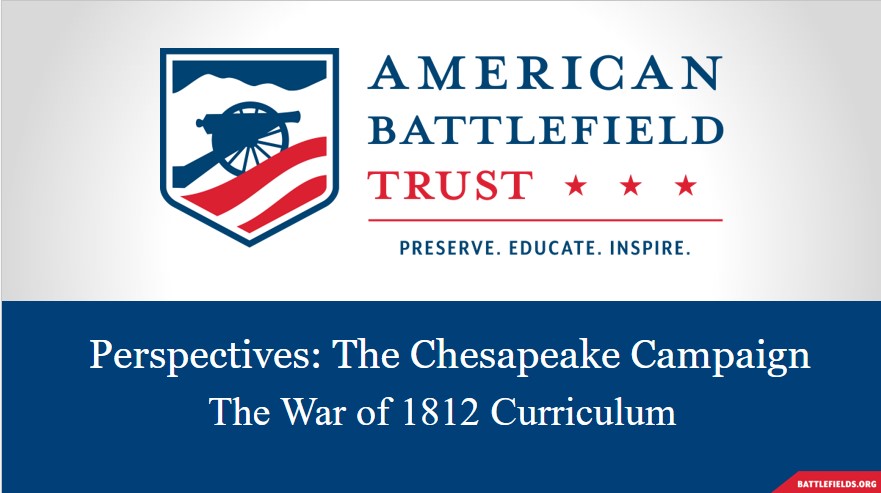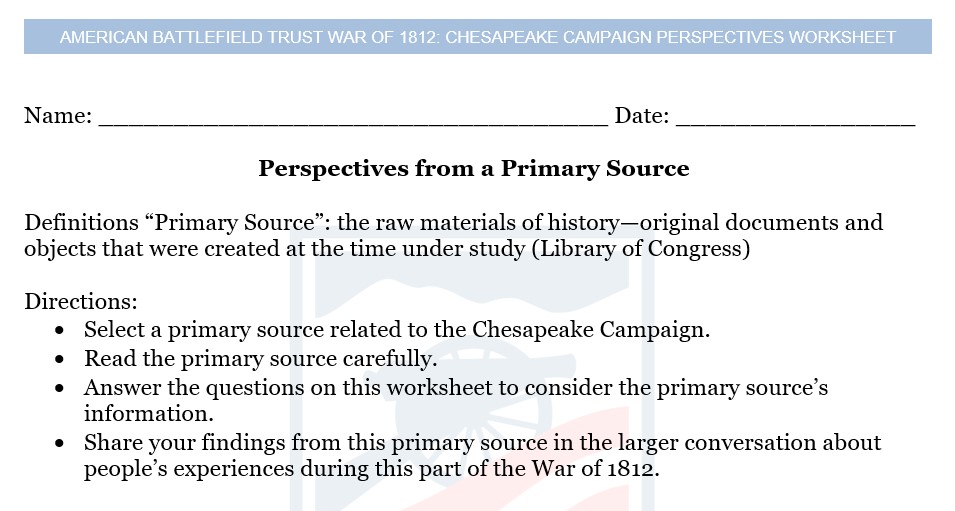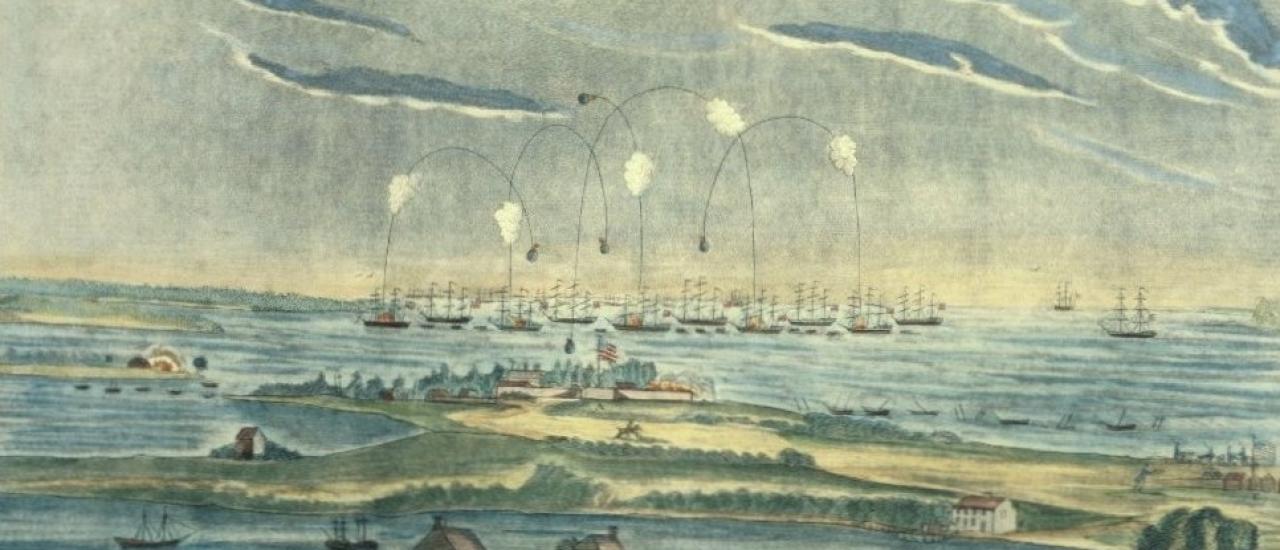
War of 1812: Chesapeake Campaign Perspectives Lesson Plan
A lesson plan for use in middle and high school classrooms.
England’s war strategy for 1813-1814 drifted southward from the Canadian frontier to the Chesapeake Bay region. America’s largest estuary was the nation’s heart of farming, commerce, ship-building and government, making it a high prize of war. In March 1814, a British squadron arrived to enforce the admiralty’s blockade declaration of the Chesapeake and Delaware Bays, making use of extensive surveys conducted of those waterways by the Royal Navy during the Revolutionary War.
In the summer of 1814, after 18 months of British occupation and raids against port towns, the British campaign against the American mid-Atlantic was building to a climax, with Baltimore in the cross-hairs. “The Clouds of war gather Fast and Heavy in the East,” wrote American Marine Captain George Stiles that July, “and all Hands are called.” The cities of Washington and Baltimore were particularly targeted in 1814. The American defeat at the Battle of Bladensburg opened the way for the British to reach the American capital where they burned government buildings. A couple of weeks later, the British tried to reach Baltimore but were defeated at the Battle of North Point and at Fort McHenry, marking the end of the Chesapeake Campaign.
This Lesson Plan can be used as a prepared resource by following this curriculum plan which aligns to NCSS and Common Core Standards.
This Lesson Plan's assets can also be used on their own as supplemental resources. The display format is prepared for easy access, exploring, and learning.
War of 1812 Perspectives Module
Upon completion of this lesson, the students will be able to:
1. Knowledge
- Briefly explain the Chesapeake Campaign, particularly noting the Burning of Washington and the bombardment of Fort McHenry
2. Comprehension/Application/Analysis
- Examine multiple primary sources to gain an appreciate for the American and British perspectives and experiences during the Chesapeake Campaign.
3. Evaluation
- Discuss findings from primary sources and consider how the Chesapeake Campaign affected the soldiers and civilian population.
Check out the Lesson Plan Teaching Guide for more instructions on using the prepared Lesson Plan.
Lesson Plan Primary Source Activity:
1. Use the Lesson’s PowerPoint to explore the context and history; the PowerPoint introduces Essential Questions and lays foundational knowledge the War of 1812 and Chesapeake Campaign.
2. Distribute or show in large size the Chesapeake Campaign map for students to examine and reference.
3. The primary sources for this perspectives lesson plan offer multiple perspectives on different events; students can be divided into groups to read and fill out the worksheet.
| Campaign | Alexander Cochrane's Proclamation |
| Washington | "The city was left a prey to the invaders" |
| Washington | "To the Inhabitants of Washington...A Night of Terror and Dismay" |
| North Point | "She was at the Battle of North Point" |
| North Point | "Undaunted we marched out" |
| Fort McHenry | "Undaunted we marched out" |
| Fort McHenry | "The enemy's fleet arranged...before Fort McHenry" |
| Fort McHenry | "The Star-Spangled Banner" |
4. Distribute the lesson’s worksheet.
5. Students will read a primary source and fill out the worksheet which will guide them through exploring the document.
6. Encourage a class discussion and draw group conclusions, answering the questions:
- How did people respond to the Chesapeake Campaign, especially the Burning of Washington and threats to Baltimore?
- What are some of the unique stories and perspectives of people affected by the War of 1812?
OPTIONAL HOMEWORK/ASSESSMENT/ADDITIONAL ACTIVITIES:
Option 1: Biography Study
Have the students selected a historical person connected to the Chesapeake Campaign. (There are six biography articles already prepared on the Lesson Plan Page). The students will read the biography and make notes for the following topics. Students can write a short essay, share their findings verbally, or incorporate their findings into a larger class project that might include art, costumes, or props.
Key Life Events:
- Identify and describe three key events or milestones in the life of the individual. How did these events shape or influence their character, achievements, or contributions?
Role in the Chesapeake Campaign
- What did this person do during the Chesapeake Campaign? Does this seem to be a significant moment in this person’s life?
Legacy and Impact:
- Reflect on the individual's legacy and impact on society. What are the person's major contributions or accomplishments? Do you think these accomplishments were good? How have their actions influenced the course of history or inspired others?
Option 2: Star-Spangled Banner Virtual Field Trip
Students can watch the Star-Spangled Virtual Field Trip, which tours Fort McHenry and other War of 1812 related sites in and around Baltimore, Maryland. Students can then write a short essay about a place of interest that they saw in the video. For additional resources related to the Star-Spangled Banner Virtual Field Trip, including more information about featured sites, please visit this resource hub/landing page.
Common Core State Standards- ELA & History/Social Studies
Grades 6-8
- Key Ideas and Details:
- CCSS.ELA-LITERACY.RH.6-8.1
- Cite specific textual evidence to support analysis of primary and secondary sources.
- CCSS.ELA-LITERACY.RH.6-8.2
- Determine the central ideas or information of a primary or secondary source; provide an accurate summary of the source distinct from prior knowledge or opinions.
- CCSS.ELA-LITERACY.RH.6-8.1
- Craft and Structure:
- CCSS.ELA-LITERACY.RH.6-8.6
- Identify aspects of a text that reveal an author's point of view or purpose (e.g., loaded language, inclusion or avoidance of particular facts).
- CCSS.ELA-LITERACY.RH.6-8.6
- Integration of Knowledge and Ideas:
- CCSS.ELA-LITERACY.RH.6-8.8
- Distinguish among fact, opinion, and reasoned judgment in a text.
- CCSS.ELA-LITERACY.RH.6-8.8
Grades 9-10
- Key Ideas and Details:
- CCSS.ELA-LITERACY.RH.9-10.1
- Cite specific textual evidence to support analysis of primary and secondary sources, attending to such features as the date and origin of the information.
- CCSS.ELA-LITERACY.RH.9-10.2
- Determine the central ideas or information of a primary or secondary source; provide an accurate summary of how key events or ideas develop over the course of the text.
- CCSS.ELA-LITERACY.RH.9-10.3
- Analyze in detail a series of events described in a text; determine whether earlier events caused later ones or simply preceded them.
- CCSS.ELA-LITERACY.RH.9-10.1
- Craft and Structure:
- CCSS.ELA-LITERACY.RH.9-10.5
- Analyze how a text uses structure to emphasize key points or advance an explanation or analysis.
- CCSS.ELA-LITERACY.RH.9-10.6
- Compare the point of view of two or more authors for how they treat the same or similar topics, including which details they include and emphasize in their respective accounts.
- CCSS.ELA-LITERACY.RH.9-10.5
- Integration of Knowledge and Ideas:
- CCSS.ELA-LITERACY.RH.9-10.8
- Assess the extent to which the reasoning and evidence in a text support the author's claims.
- CCSS.ELA-LITERACY.RH.9-10.9
- Compare and contrast treatments of the same topic in several primary and secondary sources.
- CCSS.ELA-LITERACY.RH.9-10.8
Grades 11-12
- Key Ideas and Details:
- CCSS.ELA-LITERACY.RH.11-12.1
- Cite specific textual evidence to support analysis of primary and secondary sources, connecting insights gained from specific details to an understanding of the text as a whole.
- CCSS.ELA-LITERACY.RH.11-12.2
- Determine the central ideas or information of a primary or secondary source; provide an accurate summary that makes clear the relationships among the key details and ideas.
- CCSS.ELA-LITERACY.RH.11-12.3
- Evaluate various explanations for actions or events and determine which explanation best accords with textual evidence, acknowledging where the text leaves matters uncertain.
Craft and Structure:
- Evaluate various explanations for actions or events and determine which explanation best accords with textual evidence, acknowledging where the text leaves matters uncertain.
- CCSS.ELA-LITERACY.RH.11-12.6
- Evaluate authors' differing points of view on the same historical event or issue by assessing the authors' claims, reasoning, and evidence.
- CCSS.ELA-LITERACY.RH.11-12.1
- Integration of Knowledge and Ideas:
- CCSS.ELA-LITERACY.RH.11-12.8
- Evaluate an author's premises, claims, and evidence by corroborating or challenging them with other information.
- CCSS.ELA-LITERACY.RH.11-12.9
- Integrate information from diverse sources, both primary and secondary, into a coherent understanding of an idea or event, noting discrepancies among sources.
- CCSS.ELA-LITERACY.RH.11-12.8
Social Studies - National Council for the Social Studies
- Theme 3: People, Places, and Environments
- Theme 4: Individual Development and Identity
- Theme 5: Individuals, Groups, and Institutions
- Theme 6: Power, Authority, and Governance
- Theme 9: Global Connections
This Lesson plan
contains the following:
3 Activities | 21 Resources
Audience: Middle school | High school
